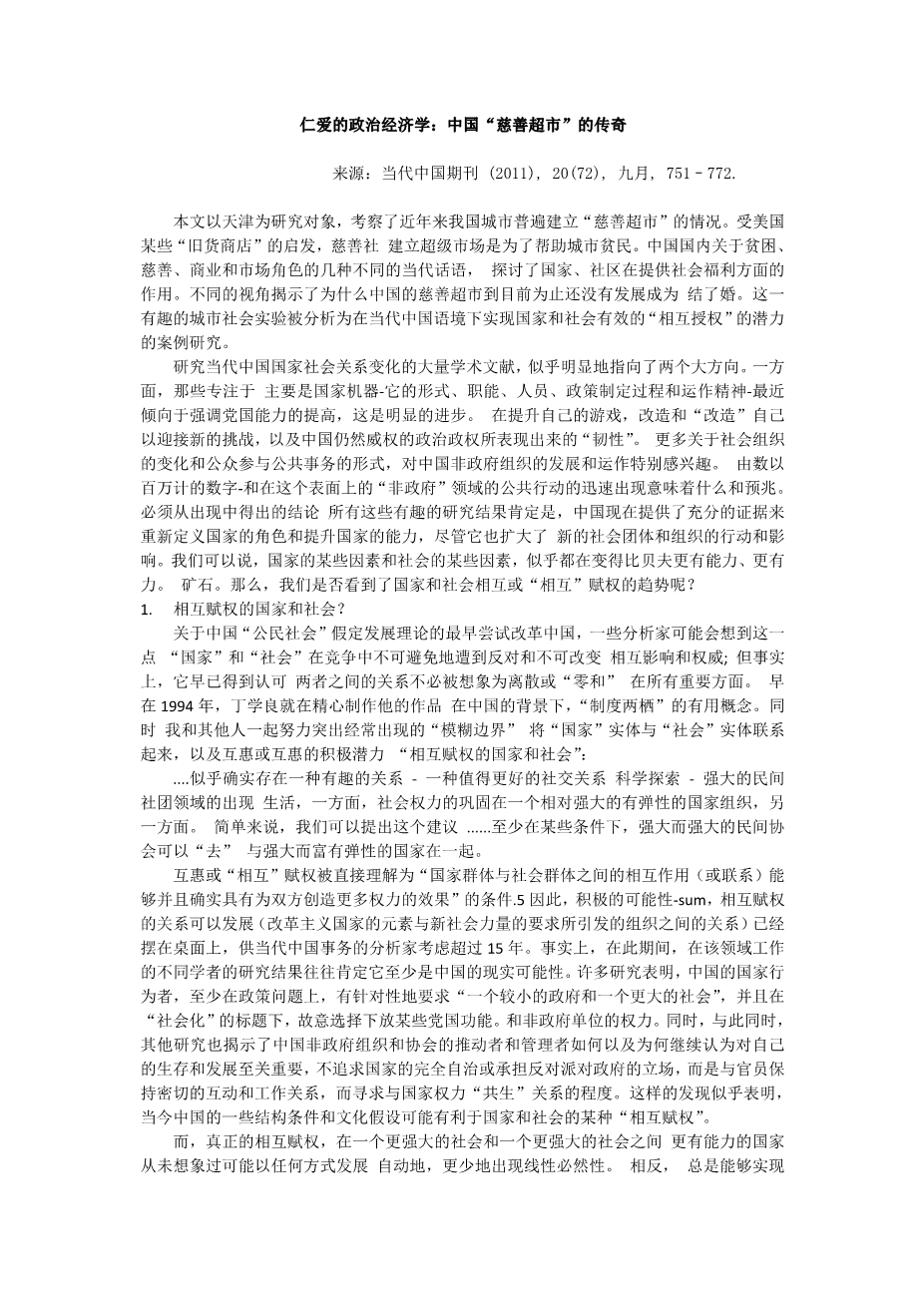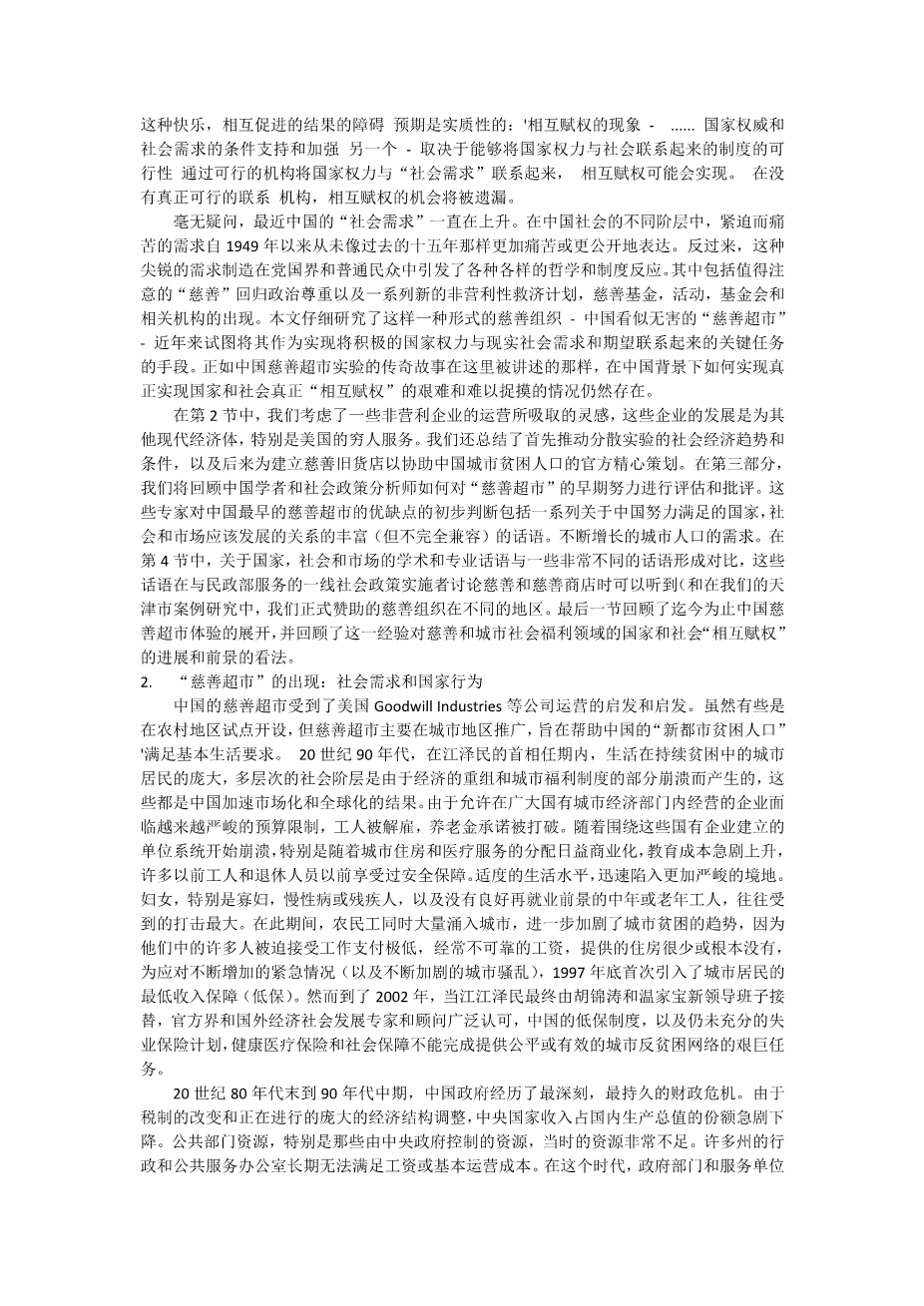外文阅读文献
The Political Economy of Compassion: Chinarsquo;s lsquo;charity supermarketrsquo; saga
来源:Journal of Contemporary China (2011), 20(72), November, 751–772.
With a focus on Tianjin, this article examines the recent widespread establishment of lsquo;charity supermarketsrsquo; in Chinarsquo;s cities. Inspired by the example of certain lsquo;thrift shopsrsquo; in the US, charity supermarkets were set up for the purpose of assisting the urban poor. Several contrasting contemporary discourses within China concerning poverty, charity, business, and the proper roles of the market, state, and community in the delivery of social welfare are explored. The differing perspectives revealed throw an interesting light on why Chinarsquo;s charity supermarkets have not, so far, developed as anticipated. This interesting urban social experiment is analyzed as a case study in the potential to achieve effective lsquo;mutual empowermentrsquo; of state and society in the contemporary Chinese context.
The abundant scholarly literature examining changing state–society relations in contemporary China seems to point plainly in two broad directions. On the one hand, those researchers who have focused primarily on the state apparatus—its forms, functions, personnel, policy formation processes and operating ethos—havetended lately to emphasize the party–statersquo;s improved capacities, its evident progress in raising its game, transforming and lsquo;reinventingrsquo; itself to meet new challenges, and the perceived lsquo;resiliencersquo; displayed by Chinarsquo;s still-authoritarian political regime.Those who have focused more on changes in social organization and on forms of popular participation in public affairs have taken an especially strong interest in the development and operations of NGOs in China—now reckoned by some to number in the millions—and in what this swift emergence of an ostensibly lsquo;non-governmentalrsquo; sphere of public action signifies andportends. The conclusion that must be drawn from the appearance of all this interesting research would surely have to be that China now gives ample evidence of redefining the roles and lifting the capacities of the state even as it also enhances the scope for action and the influence of new social groups and organizations. Both certain elements of state and certain elements of society, we might say, appear to be becoming more capable, more potent than before. Are we witnessing, then, a trend in the direction of reciprocal, or lsquo;mutualrsquo; empowerment of state and society?
- Mutual empowerment of state and society?
In the earliest attempts to theorize about the putative development of lsquo;civil societyrsquo; in reform China, there was perhaps a tendency among some analysts to conceive of lsquo;statersquo; and lsquo;societyrsquo; as being inevitably in opposition and unalterably in competition with each other for influence and authority; but it has, in fact, long been recognized that the relationship between the two need not be imagined as discrete or lsquo;zero-sumrsquo; in all important respects. As long ago as 1994, Ding Xueliang was elaborating his useful concept of lsquo;institutional amphibiousnessrsquo; in the Chinese context.Meanwhile I, along with others, was working to highlight the lsquo;blurred boundariesrsquo; that so often linked lsquo;statersquo; entities with lsquo;socialrsquo; ones, and the positive potential for reciprocal or lsquo;mutual empowerment of state and societyrsquo;:
... there does appear to be an intriguing relationship—one deserving better social scientific exploration—between the emergence of a robust sphere of civil associational life, on the one hand, and the consolidation of social power in a relatively strong or resilient state organization, on the other. Putting it in simple terms, we might propose that ... under certain conditions at least, strong and robust civil associations can lsquo;go togetherrsquo; with powerful and resilient states.
Reciprocal or lsquo;mutualrsquo; empowerment is understood, straightforwardly, as that condition in which lsquo;interactions (or linkages) between state segments and social segments can and do have the effect of creating more power for both sidesrsquo;. So, the possibility that positive-sum, mutually empowering relationships could develop (between elements of the reformist state on the one hand and organizations thrown up by the demands of new social forces on the other) has been on the table for analysts of contemporary Chinese affairs to consider for more than 15 years. Indeed, during this time the findings of different scholars working in the field have tended to affirm it at least as a live possibility for China. Many studies have shown Chinese state actors, as a matter of policy at least, pointedly demanding lsquo;a smaller government and a bigger societyrsquo; and, under the rubric of lsquo;societalizationrsquo; (社会化 ), deliberately electing to devolve certain party–state functions and powers to non-governmental units. Meanwhile, in parallel, other studies have revealed just how and why the promoters and managers of non-governmental organizations and associations in China have continued to find it essential to their own survival and development not to pursue full autonomy from the state or assume an oppositionist stance toward government, but rather to maintain close interactions and working ties with officials and seek instead what amount to lsquo;symbioticrsquo; relations with state power. Such findings might seem to suggest, then, that some of the structural conditions and cultural assumptions that could favor a certain lsquo;mutual empowermentrsquo; of state and society are in place in China today.
Genuine mutual empowerment, however, between a more robust society and a more capable state was never imagined to be likely to develop in any way automatically, much less to emerge with linear inevitability. On the contrary, the obstacles to achieving such a happy, mutually reinforcing outcome were always expected to be substantial: lsquo;The phenomenon of mutual empower
全文共37084字,剩余内容已隐藏,支付完成后下载完整资料


英语译文共 6 页,剩余内容已隐藏,支付完成后下载完整资料
资料编号:[453461],资料为PDF文档或Word文档,PDF文档可免费转换为Word
以上是毕业论文外文翻译,课题毕业论文、任务书、文献综述、开题报告、程序设计、图纸设计等资料可联系客服协助查找。


